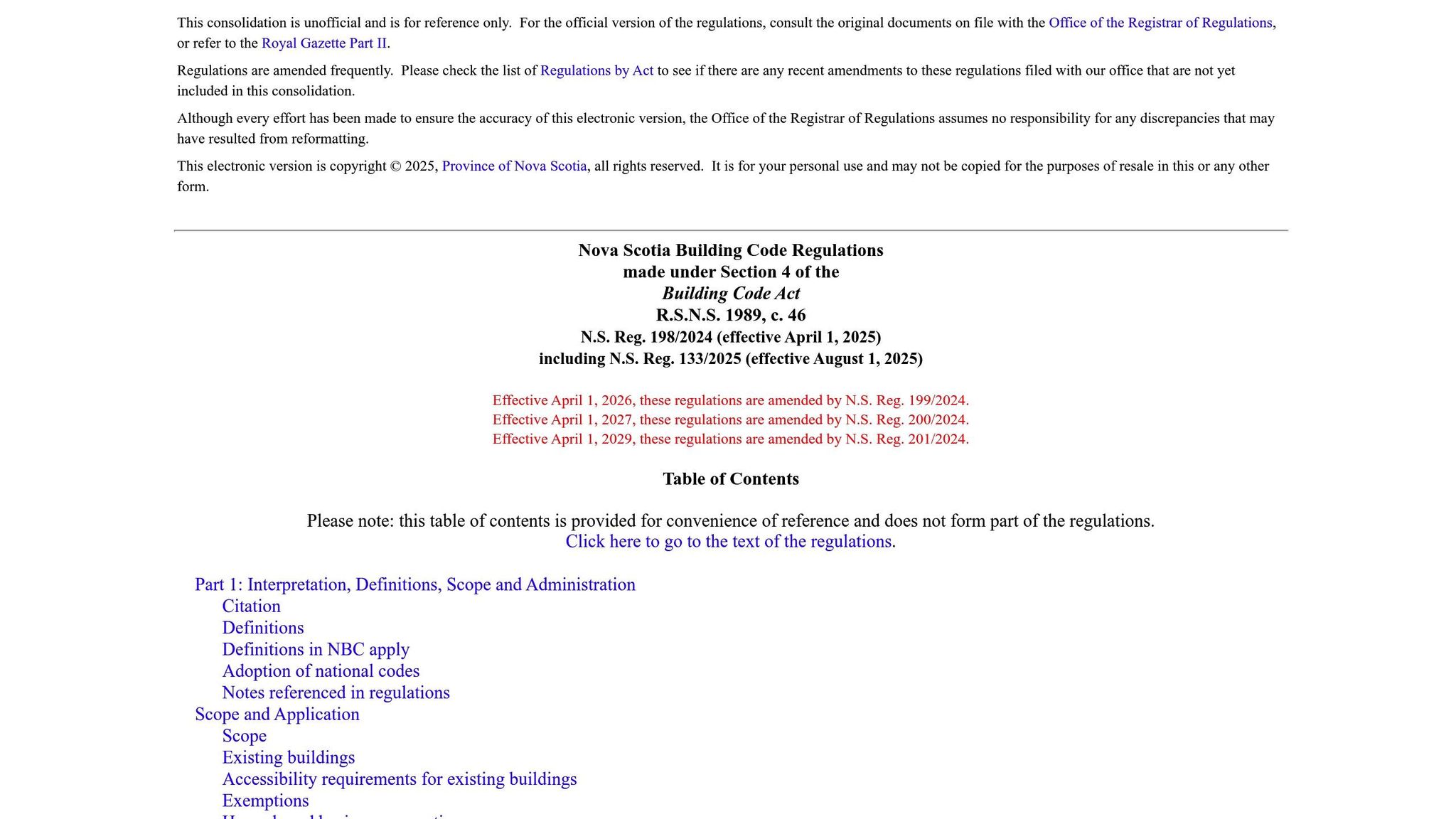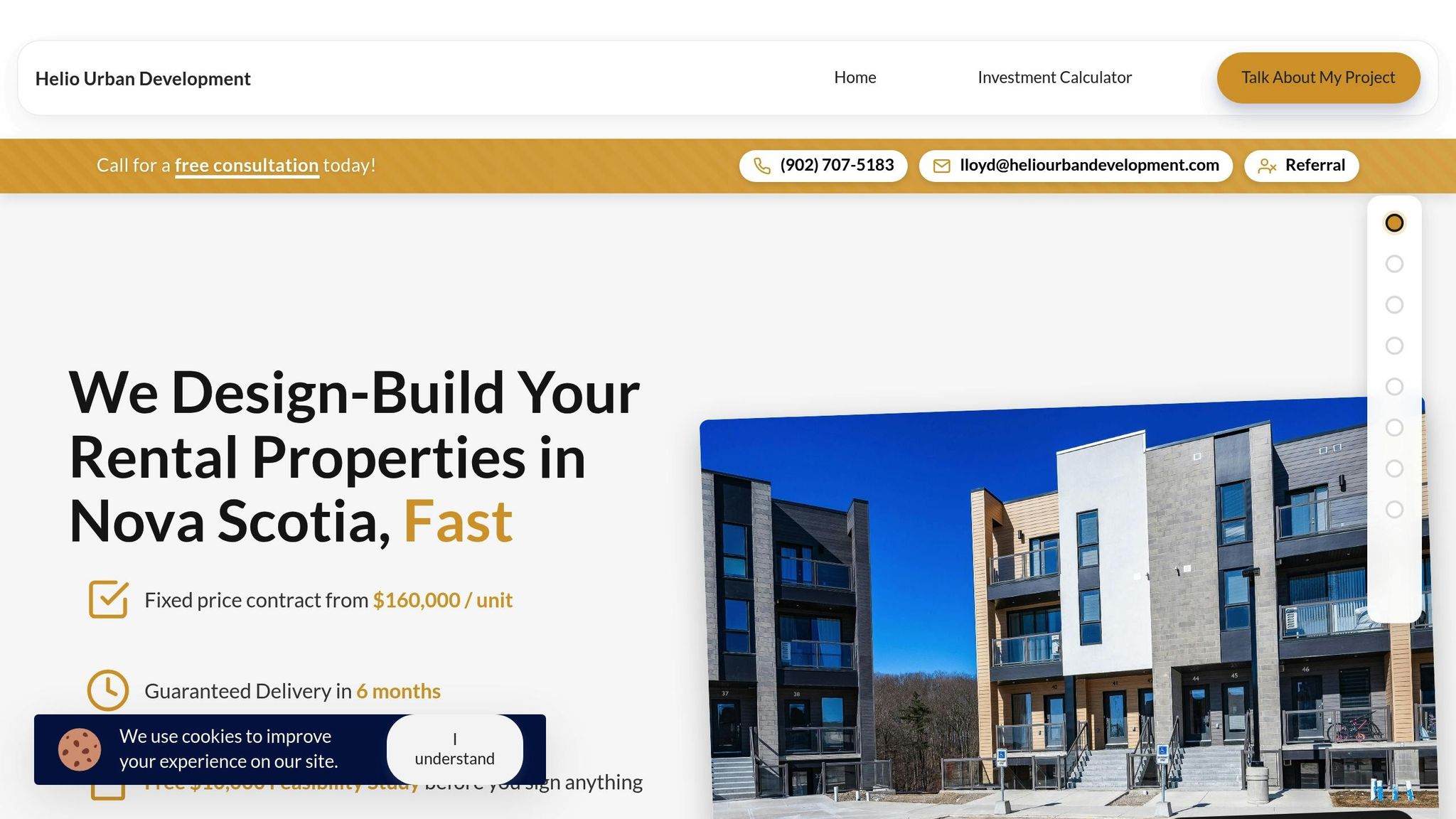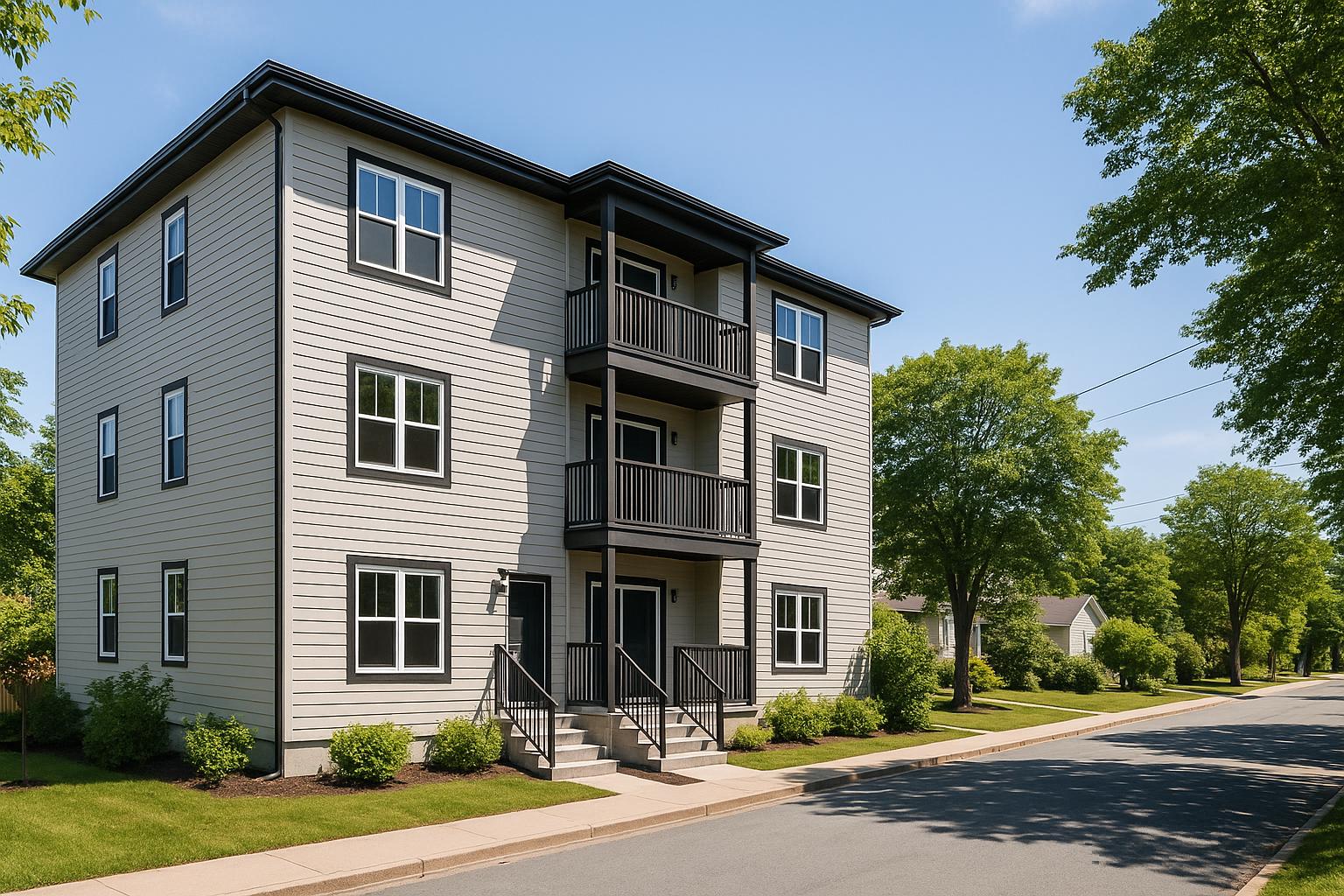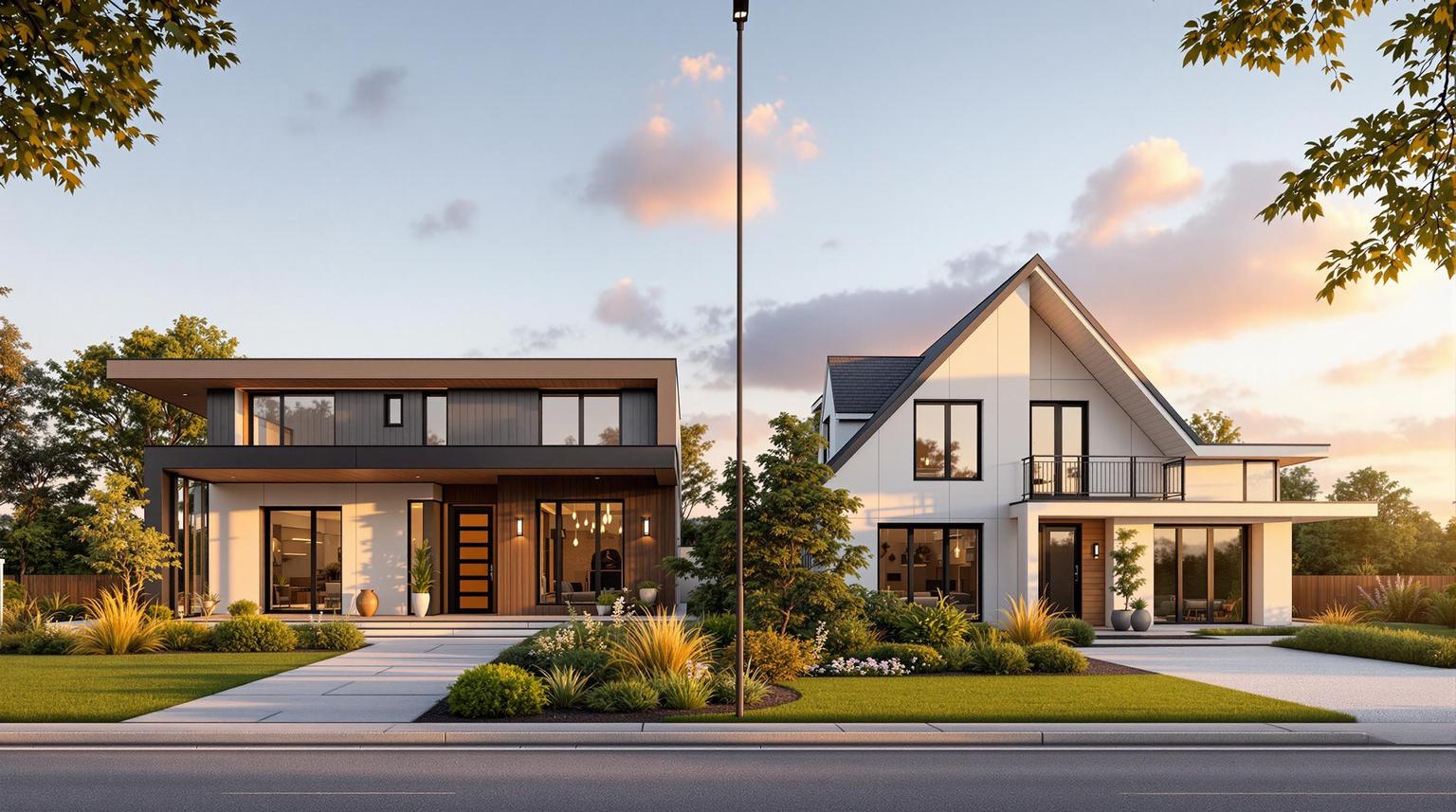HR-1 zoning in Halifax allows property owners to build up to 14 residential units on a single property, opening up opportunities for higher rental income. But the process is far from simple. Between zoning rules, permitting, and construction challenges, careful planning is essential to make these projects successful.
Key points:
- HR-1 zoning supports multi-unit developments, including townhouses and mid-rise buildings, with density limits of up to 14 units per property.
- Zoning rules include height caps (4 storeys), lot coverage limits (40–60%), parking requirements, and landscaping standards.
- Construction costs average $160,000 per unit, with two-bedroom units renting for $1,950–$2,100/month, delivering potential annual returns of 12–20%.
- Challenges include urban space constraints, complex permitting, and risks of delays or budget overruns.
- Design-build construction simplifies the process by integrating design and construction teams, reducing delays and cost overruns.
This article explores how to navigate HR-1 zoning rules, overcome construction hurdles, and optimize project timelines for better returns.
HALIFAX Home Owners May Have Just Won THE LOTTERY : Halifax Proposed Zoning Changes January 2024
HR-1 Zone Rules and Requirements
Once you've outlined your project using zoning rules, the next step is obtaining the necessary permits. If you're working within an HR-1 zone, understanding its regulations is essential. These rules influence everything from the design of your building to its overall cost, and compliance is key to a successful project.
Main Zoning Rules
HR-1 zoning has specific requirements for height, setbacks, Floor Area Ratio (FAR), lot coverage, parking, and landscaping. For example, building heights are capped at four storeys (14 metres), and FAR typically ranges between 1.5 and 2.5, which establishes limits on both size and density.
Setbacks are another important consideration. Front setbacks range from 3 to 6 metres, while side and rear setbacks vary depending on the lot. These restrictions directly affect how much of the property you can build on, impacting both unit numbers and the overall scale of the project.
To put this into perspective, if you have a 500-square-metre lot with an FAR of 2.0, you could build up to 1,000 square metres of total floor area across all levels.
Lot coverage rules dictate how much of the ground area your building can occupy. In most HR-1 zones, coverage is limited to 40–60% of the total lot area. This ensures there’s enough outdoor space and helps avoid overcrowding on smaller lots.
Parking requirements can vary widely depending on the location. Some areas mandate one parking space per unit, while transit-oriented developments may require fewer spaces - or none at all. Identifying these requirements early can help you avoid costly redesigns later.
Landscaping rules typically require 20–30% of your lot to remain as landscaped open space. These areas often play a role in stormwater management, which is a growing priority under Halifax’s updated development guidelines.
Halifax Permitting Process
The permitting process for HR-1 projects begins with development permits, which focus on zoning compliance, site layout, and integration with the surrounding neighbourhood. For straightforward projects, this stage usually takes 6–12 weeks.
To apply for a development permit, you’ll need to submit site plans, elevation drawings, and landscaping designs. These are reviewed against the Regional Centre Land Use By-law. During site plan approval, factors like drainage, servicing, and traffic impact are also evaluated.
Once development approval is secured, the next step is obtaining building permits. This stage ensures structural safety and compliance with building codes. It requires detailed construction drawings and engineering reports, and the review process typically takes 4–8 weeks for multi-unit developments.
For more complex projects, expect multiple review cycles and potential revisions, which can extend your timeline. Careful planning is essential to avoid delays.
During construction, inspection scheduling becomes critical. Halifax mandates inspections at key stages, including foundation, framing, insulation, and final occupancy. Properly timing these inspections can save you from unnecessary delays and added costs.
Depending on your project’s location and scope, you may also need additional approvals, such as heritage reviews, environmental assessments, or traffic studies.
Nova Scotia Building Code Requirements

The Nova Scotia Building Code sets the standards for multi-unit residential construction. For buildings with more than three units, fire safety is a major focus. This includes one-hour fire-rated separations between units and two-hour ratings for exit stairwells.
Accessibility standards require barrier-free access to common areas, with larger buildings needing a percentage of accessible units. For example, structures with 10 or more units must include 5–10% accessible units.
To address noise control, the code mandates specific wall and floor assemblies to reduce sound transmission. This often involves enhanced insulation, resilient channels, and specialized flooring, which can increase construction costs.
Egress requirements also grow more complex with larger buildings. Those over three storeys must have two separate exit routes, fire-rated stairwells, and emergency lighting systems. These elements significantly influence building layouts and costs.
Ventilation is another key area. Each unit must have an HRV or ERV system, and common areas must meet prescribed ventilation rates. These systems are required to meet specific air change and energy efficiency standards.
The code also includes energy efficiency requirements, such as minimum insulation levels, high-performance windows, and air tightness testing. Many developers opt for building envelope systems that exceed minimum standards, as these can reduce long-term operating costs and improve unit profitability.
For buildings over three storeys, structural requirements become more demanding. Engineered structural systems replace conventional wood framing, adding design complexity and cost.
Finally, plumbing and electrical systems must meet standards for multi-unit occupancy. This includes ensuring adequate water pressure, properly sized electrical services, and compliant fire alarm systems. These systems often require input from engineers and specialized installation techniques.
Meeting these code requirements is essential for navigating the challenges of HR-1 projects and ensuring a safe, efficient, and compliant building.
Construction Challenges in HR-1 Zones
Navigating construction in HR-1 zones comes with its own set of hurdles. These areas demand high-density development while adhering to strict zoning regulations, making efficient use of urban space and team coordination a tough balancing act. Building multi-unit properties in such zones often stretches timelines and impacts profitability.
Urban Building Site Limitations
Space is a luxury in established urban neighbourhoods. With limited staging areas, storage, and delivery access, logistics can quickly become a headache. On top of that, coordinating with municipal services to secure utility connections and manage site access adds another layer of complexity. These spatial constraints require meticulous planning and scheduling to avoid disruptions and keep the project moving forward.
Project Management and Budget Problems
Traditional construction methods often rely on separate contracts for architects, engineers, and trades, which can lead to a lack of coordination. This fragmented approach is a common culprit behind cost overruns, which can range from 30–60% [2]. Misaligned schedules between contractors frequently result in overlapping work - think electrical and plumbing teams stepping on each other's toes - causing delays and unplanned expenses, especially under cost-plus pricing models.
Budgeting under traditional methods also comes with its own set of uncertainties. Property owners often face unexpected costs due to unforeseen site conditions or mid-project design changes. These challenges highlight the importance of adopting a more unified construction strategy.
Common Construction Problems
Poor coordination can give rise to several additional issues, including:
- Delays in permitting: Disjointed design documents can lead to extended review times by municipal planning departments.
- Increased change orders: Design conflicts or unexpected site conditions often trigger costly modifications.
- Quality assurance gaps: Without a single party overseeing project quality, disputes between consultants and contractors can compromise construction standards.
- Weather-related disruptions: In colder climates, adverse weather can derail schedules, especially if planning isn’t precise.
- Inspection delays: Lack of coordination among trades can push back municipal inspections, causing further setbacks.
- Technology breakdowns: Incompatible project management tools or communication systems can lead to information gaps, rework, and inefficiencies.
Adopting an integrated project management model, where design, engineering, and construction are aligned from the start, can significantly reduce these risks. This approach offers clearer timelines and tighter budget control, making it easier to navigate the complexities of HR-1 zone construction.
Design-Build Construction Method
With the challenges of traditional construction methods, many property owners are opting for design-build construction - a more efficient approach, particularly suited to the complex demands of multi-unit HR-1 projects. This method tackles the common pitfalls of poor coordination and budget unpredictability, which often make such projects risky.
How Design-Build Works
The design-build model integrates architects, engineers, planners, and construction crews under one unified contract, eliminating the need for multiple agreements. Instead of juggling different teams, property owners work with a single group that oversees everything, from the initial design to the final build.
Here’s how it works: architects and engineers from the design-build firm collaborate directly with construction managers from the very beginning. This early partnership helps identify and resolve potential construction challenges during the design phase - long before shovels hit the ground. The result? A more synchronized process where everyone is on the same page regarding project goals and timelines.
One of the standout features of this method is single-point accountability. With one team managing the entire project, disputes over delays or cost overruns are minimized. This streamlined approach ensures timelines remain predictable and pricing stays clear from the outset.
Advantages of Design-Build
The design-build model shines when it comes to complex HR-1 zone projects, where seamless coordination is critical. One of the most appealing aspects is fixed-price contracts, which provide property owners with upfront cost certainty. With pricing locked in before construction begins, financial surprises are far less likely.
Another key advantage is timeline reliability. When design and construction teams collaborate from day one, they can create realistic schedules that factor in everything from permits to material deliveries. This level of planning often shortens construction timelines significantly compared to traditional methods, where miscommunication and poor coordination can cause delays.
Quality control also gets a boost. By overseeing both the design and construction phases, design-build firms can ensure that the final product meets high standards. This integrated oversight reduces the risk of quality issues that might arise when multiple, uncoordinated parties are involved.
Finally, communication becomes much simpler for property owners. Instead of chasing updates from various contractors, they have a single point of contact for all project-related questions and updates, making the process far less stressful.
Example: Helio Urban Development

The practical benefits of the design-build model can be seen in the work of Helio Urban Development, which specializes in HR-1 zone construction in Nova Scotia. Helio’s approach unites planners, architects, engineers, and construction crews into one cohesive team, eliminating inefficiencies caused by fragmented processes. This streamlined coordination, which Helio refers to as "coordination waste", saves property owners an average of $47,000 per project compared to traditional construction methods.
Helio offers fixed-price construction at $160,000 per unit, with a guaranteed 6-month timeline. If the project runs late, they pay penalties of up to $1,000 per day. This financial commitment reflects the confidence that comes from their integrated project management and meticulous coordination.
"I personally guarantee every timeline because I've felt the pain of construction delays", says Lloyd Liu, Helio's co-founder and CEO, who has overseen over $30 million in construction projects during his career as an investment banker.
Currently, Helio has 31 units under construction across Nova Scotia, with plans for 131 more. They serve property owners within a 90-minute radius of Halifax, offering daily photo updates, triple quality verification by professional engineers, and a 2-year warranty on all work.
Helio’s scheduling system, created by co-founder Yuan He, is designed to prevent the delays that can turn an 8-month project into an 18-month ordeal. By leveraging technology for precise construction coordination, Helio demonstrates how the design-build model can deliver reliable results - especially in HR-1 zone projects where timing and budget control are crucial for success.
How to Build Successfully in HR-1 Zones
Taking on an HR-1 project requires careful planning and a clear understanding of urban development challenges. While market conditions present great potential, success hinges on following proven strategies.
Construction Process Steps
Start with a site feasibility assessment. This involves evaluating your lot's dimensions, setbacks, and density limits. By addressing these factors early, you can avoid costly surprises down the line.
Once feasibility is confirmed, secure all the necessary permits. Halifax’s permitting process can move more smoothly when you work with professionals familiar with local zoning requirements. A well-prepared application that addresses compliance from the start can save you time and headaches.
During the design phase, focus on maximizing density without breaking the rules. HR-1 zones permit up to 14 units, but achieving this requires careful attention to height restrictions, parking allocations, and landscaping requirements. Engaging skilled designers and planners ensures you can make the most of your lot while staying within the rules.
When construction begins, coordination is key. Multi-unit projects involve multiple trades working in sequence. Daily progress checks and open communication among all parties help keep things moving efficiently.
Finally, before you can start collecting rent, secure all final inspections and occupancy permits. Conduct pre-inspections to catch and resolve any issues early, avoiding delays at the finish line.
By following these steps, you'll be better positioned to balance construction costs with potential returns.
Managing Costs and Returns
Rising costs for labour, materials, and supply chain issues are making multi-residential projects more challenging [3]. To protect your investment, consider fixed-price construction contracts, which can help safeguard your returns from unexpected cost increases.
In Halifax, successful HR-1 projects can achieve annual returns of 12–20%. For example, well-designed two-bedroom units can rent for $1,950–$2,100 per month, while construction costs average $160,000 per unit. This creates a strong cash flow opportunity for property owners.
Financing options like CMHC’s MLI Select program can further enhance your project’s financial viability. With 95% financing available and only a 5% down payment required, this program allows you to leverage your investment. However, it does come with higher construction standards, adding about $40,000 per unit to your costs. Despite this, the improved financing terms often mean your project can generate positive cash flow from day one.
Timing is a critical factor in financial planning. Standard construction timelines of 12–18 months can lead to extended periods without rental income. On the other hand, completing a project in just six months can save owners approximately $8,800 per month in opportunity costs for a typical fourplex.
While managing costs is crucial, avoiding common mistakes can make or break your project.
Mistakes to Avoid
One major pitfall is hiring disconnected contractors. Relying on a fragmented team can lead to coordination issues among the six or more professionals involved, resulting in budget overruns of 30–60% and communication failures. A unified team approach can help avoid these challenges.
Another costly mistake is underestimating urban site constraints. These can lead to unexpected expenses and delays, so factor them into your planning from the start.
Choosing contractors based solely on the lowest bid often backfires. Unrealistic pricing can lead to cost overruns, frequent change orders, and subpar quality. Instead, work with contractors who provide detailed, realistic estimates and back their pricing with contractual guarantees.
Cutting corners on quality may save money upfront, but it can lead to higher maintenance costs, more tenant turnover, and reduced rental income in the long run. The initial savings rarely outweigh these longer-term expenses.
Finally, effective timeline management is essential. A project planned for eight months but stretched to 18 months not only delays rental income but also adds significant costs. To avoid this, insist on realistic schedules with penalties for delays, ensuring contractors stay accountable.
Daily oversight is equally critical. Regular updates and photo documentation help catch issues early, keeping your project on track and within budget.
sbb-itb-16b8a48
HR-1 Zone Construction: Final Thoughts
HR-1 zoning in Halifax presents property owners with a chance to generate substantial rental income. These zones allow for much higher density compared to traditional residential areas, opening up opportunities that far surpass those available in standard residential zoning [1].
From a financial perspective, HR-1 projects can deliver impressive returns. With two-bedroom units renting for $1,950–$2,100 per month and construction costs averaging $160,000 per unit, annual returns often range between 12–20%. For property owners who plan carefully and execute well, the numbers can be highly rewarding.
However, these projects come with challenges. Urban sites often have space constraints, permitting processes can be complex, and coordinating multiple trades can lead to significant delays and cost overruns. The key to success lies in selecting the right construction approach right from the beginning.
When construction is fragmented across uncoordinated professionals, the risks are high. Budget overruns of 30–60% and delays that turn eight-month projects into 18-month headaches are all too common. This not only inflates costs but also delays rental income, leaving property owners in a tough spot.
A better alternative is the design-build approach, which integrates planning, design, engineering, and construction under one management team. This streamlined method avoids the finger-pointing and miscommunication that often derail traditional projects. For example, Helio Urban Development has demonstrated how this approach can effectively handle the complexities of HR-1 zoning while keeping costs and timelines under control [1].
Fixed-price contracts with timeline guarantees add another layer of security. When contractors face penalties for delays – such as $1,000 per day – they are incentivized to stay on schedule, reducing uncertainty for property owners.
To tackle the challenges of urban construction, a methodical and integrated strategy is essential. Success in HR-1 development hinges on early planning, including consultations with municipal planners, thorough site feasibility studies, and partnerships with experienced design-build teams. These steps can make the difference between a profitable project and an expensive setback.
The potential in HR-1 zones is undeniable, but achieving success requires more than just optimism. Property owners who prioritize systematic project delivery and carefully choose their construction partners will be well-positioned to take advantage of Halifax's evolving housing market.
FAQs
What are the benefits of using a design-build approach for HR-1 zoning projects in Halifax?
Why Choose a Design-Build Approach for HR-1 Zoning Projects in Halifax?
Opting for a design-build approach in HR-1 zoning projects in Halifax can make life much easier for property owners. This method merges the design and construction phases into a single contract, creating a smoother process with fewer headaches. By having one team handle everything, you’ll see better coordination and fewer delays.
Here’s what you can count on with design-build: shorter project timelines, set costs upfront, and fewer unexpected issues during construction. Plus, you won’t have to juggle multiple contractors, which means a more straightforward and predictable process compared to traditional methods. For those tackling multi-unit builds in HR-1 zones, design-build simplifies complex decisions, ensures compliance with local regulations, and helps you get the most out of your investment.
What steps can property owners take to navigate permit and zoning challenges in HR-1 zones?
Navigating Permit and Zoning Challenges in HR-1 Zones
To tackle permit and zoning hurdles in HR-1 zones, property owners need to start by digging into the local zoning rules. This means understanding what kinds of multi-unit dwellings are permitted and knowing the specific density limits for the area. Familiarizing yourself with the Halifax Regional Municipality's permit application process - like which documents you’ll need and the inspection steps involved - can help you dodge unnecessary delays.
Bringing in professionals, such as planners, architects, or consultants, early in the game can make a big difference. These experts can pinpoint potential issues and ensure your project stays aligned with development standards. By working closely with both professionals and municipal authorities, you can create a smoother approval process. This collaborative approach not only saves time but also adds a level of predictability, helping property owners push their projects forward with greater ease and confidence.
What are the key mistakes to avoid when planning a multi-unit residential project in an HR-1 zone in Halifax?
Common Pitfalls in HR-1 Zone Multi-Unit Residential Projects
When working on a multi-unit residential project in an HR-1 zone, miscommunication and lack of coordination among contractors can be a major stumbling block. These issues often lead to mistakes during both the design and construction phases, resulting in expensive delays. Ensuring that everyone involved is on the same page from the start is key to avoiding such setbacks.
Another common error is overlooking local zoning and building regulations, such as density limits or requirements for amenity spaces. Ignoring these rules can lead to permit rejections, legal troubles, or the need for costly redesigns. To steer clear of these problems, it's essential to have a solid grasp of HR-1 zoning regulations and to consult with professionals early in the process.
By prioritizing detailed planning, maintaining clear communication, and staying up to date on local requirements, you can keep your project running smoothly and in compliance with all regulations.



